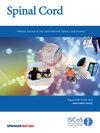Factors impacting employment outcomes for persons with spinal cord injury in South Korea
IF 2.2
4区 医学
Q3 CLINICAL NEUROLOGY
引用次数: 0
Abstract
Cross-sectional survey. To identify the factors determining the employment of individuals with spinal cord injury (SCI) living in South Korea, which shows a lower-than-average employment rate in international comparative studies, and to examine the potential importance for policy. Community of patients with SCI who are members of the Korea Spinal Cord Injury Association (KSCIA). A survey involving 200 members of the KSCIA was conducted. In the analysis, we included 177 individuals aged 15–64 years and were at least 2 years post-injury at the time of the survey. Descriptive statistics were calculated and logistic regression was applied to examine the association between 11 variables and employment outcomes. A higher “education level” and participation in “vocational rehabilitation services” were positively associated with employment for individuals with SCI. By contrast, “receiving welfare benefits” was negatively associated with employment probability. The analysis, which categorized employment predictors into human capital, injury, and environmental models, showed no associations for factors in the Injury Model but indicated positive associations for education in the Human Capital Model and for receiving compensation in the form of welfare benefits and participation in vocational rehabilitation services in the Environment Model. Among the three models, the Environment Model had the greatest explanatory power. This suggests that in Korea, policy interventions targeting modifiable environmental factors hold significant potential to improve employment outcomes for individuals with SCI.影响韩国脊髓损伤患者就业结果的因素。
研究设计:横断面调查。目的:确定决定韩国脊髓损伤(SCI)患者就业的因素,韩国在国际比较研究中显示出低于平均水平的就业率,并研究其对政策的潜在重要性。背景:韩国脊髓损伤协会(KSCIA)成员的SCI患者社区。方法:对200名协会会员进行问卷调查。在分析中,我们纳入了177名年龄在15-64岁之间的个体,并且在调查时受伤后至少2年。计算描述性统计数据,并应用逻辑回归来检验11个变量与就业结果之间的关系。结果:较高的“受教育程度”和参与“职业康复服务”与脊髓损伤个体的就业呈正相关。相反,“领取福利”与就业概率呈负相关。该分析将就业预测因素分为人力资本、伤害和环境模型,结果显示伤害模型中的因素没有关联,但人力资本模型中的教育与环境模型中的福利待遇和职业康复服务的参与呈正相关。结论:在三个模型中,环境模型的解释力最强。这表明,在韩国,针对可改变的环境因素的政策干预具有显著的潜力,可以改善脊髓损伤患者的就业结果。
本文章由计算机程序翻译,如有差异,请以英文原文为准。
求助全文
约1分钟内获得全文
求助全文
来源期刊

Spinal cord
医学-临床神经学
CiteScore
4.50
自引率
9.10%
发文量
142
审稿时长
2 months
期刊介绍:
Spinal Cord is a specialised, international journal that has been publishing spinal cord related manuscripts since 1963. It appears monthly, online and in print, and accepts contributions on spinal cord anatomy, physiology, management of injury and disease, and the quality of life and life circumstances of people with a spinal cord injury. Spinal Cord is multi-disciplinary and publishes contributions across the entire spectrum of research ranging from basic science to applied clinical research. It focuses on high quality original research, systematic reviews and narrative reviews.
Spinal Cord''s sister journal Spinal Cord Series and Cases: Clinical Management in Spinal Cord Disorders publishes high quality case reports, small case series, pilot and retrospective studies perspectives, Pulse survey articles, Point-couterpoint articles, correspondences and book reviews. It specialises in material that addresses all aspects of life for persons with spinal cord injuries or disorders. For more information, please see the aims and scope of Spinal Cord Series and Cases.
 求助内容:
求助内容: 应助结果提醒方式:
应助结果提醒方式:


